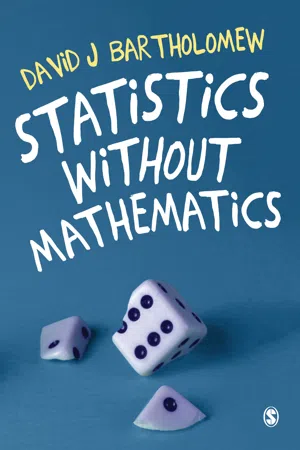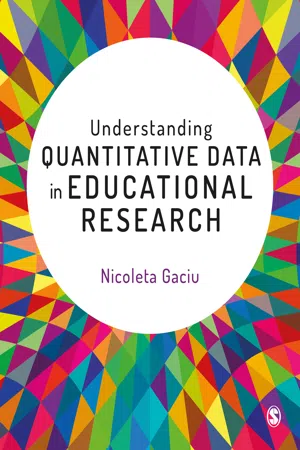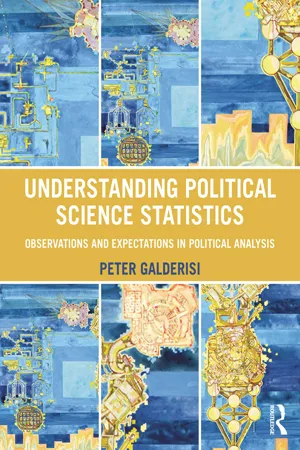Inferences in Statistics
In statistics, inferences refer to the process of drawing conclusions or making predictions about a population based on sample data. This involves using statistical methods to estimate parameters, test hypotheses, and make generalizations. Inferences play a crucial role in understanding and interpreting data, and they help in making informed decisions in various fields such as science, business, and social sciences.
8 Key excerpts on "Inferences in Statistics"
- eBook - ePub
- David J. Bartholomew(Author)
- 2015(Publication Date)
- SAGE Publications Ltd(Publisher)
...8 Introduction to the Ideas of Inference Summary The key idea underlying this chapter is the sampling distribution. This chapter outlines some of the basic ideas of hypothesis testing and confidence intervals and introduces some terminology, including significance and P -value. Introduction Statistical inference concerns drawing conclusions about a population on the evidence of a sample taken from it. The possibility of doing this depends upon how the sample has been obtained. In the previous chapter we faced the problem of how to choose a sample which was representative, and concluded that a simple random sample was the simplest way of doing this. It is the method of drawing the sample which provides the bridge from the data that we have, the sample, to the data we would like to have had, the population. Such sampling methods are sometimes described as probability sampling because of the implicit probabilistic element in the definition in the sampling method. We have deliberately played down this aspect because probability ideas have not been used so far, although the notion underlies the more intuitive idea of all samples being ‘equally likely’. Inference is often seen as one of the more difficult aspects of Statistics, but it plays a dominant role in many presentations of the subject, including many at the elementary level. We shall therefore approach it in easy stages, contending that most of the ideas are familiar in everyday reasoning. The only difference here is that they are refined and made more precise. A central idea is that of the sampling distribution, but we have deferred this to the next chapter because it is possible to lay the foundation before bringing that concept into the picture. The Essence of the Testing Problem We begin by posing a very simple question, the answer to which introduces the essential ideas without introducing any new concepts...
- Nicoleta Gaciu(Author)
- 2020(Publication Date)
- SAGE Publications Ltd(Publisher)
...When we want, for example, to evaluate the effectiveness of a teaching strategy, we usually collect data from one or more samples of students and then, using inferential statistics based on the sample data, we can make an inference about the population of students. This chapter is the first of two that elaborate on statistical inference, which is an essential process applied to either estimation or hypothesis testing to connect populations and samples. The first use of inferential statistics is to evaluate the accuracy of estimates of population parameters based on sample statistics, which is called inferential statistics for estimation. The second use of inferential statistics, which is called hypothesis testing, is to assess the probability of specific sample results under certain population conditions. With hypothesis testing, the assumptions about the population parameter are made in advance, and the sample is tested to confirm or to contradict these assumptions. The two aspects of statistical inference mentioned above can be formulated by asking ‘What is the value of a population parameter?’ and ‘What is the probability that the population parameter is equal to a specified value?’, and followed by a test of significance which is used to assess the strength of evidence against the hypothesis. 7.2 From sample to population A population refers to a complete set of elements (people, objects, values or events) that have some common characteristics which are established by the researcher. There are two kinds of populations: target and accessible. The target population is the entire group of elements to which the researcher will generalise the findings, and the accessible population is that proportion of the target population to which the researcher has access. The characteristics or measures of a population are called parameters...
- eBook - ePub
Recipes for Science
An Introduction to Scientific Methods and Reasoning
- Angela Potochnik, Matteo Colombo, Cory Wright(Authors)
- 2018(Publication Date)
- Routledge(Publisher)
...Coin tosses, dice throws, LeBron’s free throws, voting intentions, temperatures on the days of September, and the decibel level in a bar can all be treated as random variables. For any of these variables, inferential statistics allows us to analyze relevant data sets to predict yet-to-be-measured values of those variables. For example, one might assess from a sequence of heads and tails whether the coin is fair, predict from LeBron’s past record whether his free throw success will improve over time, infer the efficacy of a medical drug from observed treatment effects, or predict from an opinion poll which candidate will win an election. In brief, statistical inference is a form of inductive inference that employs probability to better understand the real-world phenomenon underlying a known data set. It allows scientists to formulate expectations about what they would observe in a new data set or in the larger population and to assess how confident they can be about those expectations. Frequency Distributions and Probability Distributions The starting point for using inferential statistics is a properly organized data set. Frequency distributions offer one way to organize a given set of raw data before we can use it to make predictions about new observations. Frequency distributions are lists that include every possible value of a variable and the number of times each value of that variable appears in the data set, often organized into tables— Tables 5.2 and 5.3 in the previous chapter are examples of frequency distributions of students’ grades. Relative frequency distributions are frequency distributions that record the proportion of occurrences of the value of a certain variable instead of the absolute number of occurrences. By using relative frequency distributions, we record how often different values occur for the variable under consideration, relative to the total number of values in the data set...
- eBook - ePub
- S Alexander Haslam, Craig McGarty(Authors)
- 2018(Publication Date)
- SAGE Publications Ltd(Publisher)
...7 Some Principles of Statistical Inference Key goals for this chapter Identify two forms of uncertainty in psychological data – one relating to our capacity to describe phenomena (descriptive uncertainty), and one relating to our capacity to describe the significance of those phenomena (inferential uncertainty). Explain why and how we address inferential uncertainty by understanding and making probability statements based on the likelihood of observed events occurring by chance. Outline principles for making inferences about individual data points and about sets of data points. As we outlined in Chapter 2, a major part of research in psychology involves making decisions about how confident we should be in the conclusions we draw from research data. Statistics allow us to express this degree of confidence in numerical terms. This is a useful thing to do because it allows us to say clearly when we have great confidence in the pattern of findings we observe and when we are not so sure about them. In this chapter we are concerned with how we go about making those decisions. Imagine that you have conducted a piece of research where you have followed all the steps we have outlined in the book so far. The research might be an experiment with a control condition and a theoretically interesting experimental condition and you have randomly assigned participants to those conditions. Imagine you have eliminated all confounds and have a dependent variable that is both relevant to the question in which you are interested and sensitive to changes in the independent variable. You have collected the data and calculated the means and standard deviations, and you now want to know whether the theory you set out to test is supported or not. If there is a difference between the mean scores obtained for the experimental and control groups, you will want to know whether you should take that difference seriously, or just consider it as a chance event...
- eBook - ePub
- Norman H. Anderson(Author)
- 2001(Publication Date)
- Psychology Press(Publisher)
...Chapter 2 STATISTICAL INFERENCE * All science rests on evidence from samples. A sample, however, cannot provide an exact picture of the population from which it came. A sample mean, in particular, will always differ from the population mean. It follows that a sample mean should be represented as an interval of uncertainty. It is only meaningful when accompanied by its likely error from the population mean. a This view of the sample mean as an interval of likely error is vital in principle. In practice, this view may seem too vague, too indeterminate to be useful. Is it really possible to specify an exact value of likely error? Remarkably, the answer is yes: Statistical theory has found a way to measure uncertainty. The sow’s ear of variability in the sample can be transformed into the silk purse of a confidence interval. The confidence interval epitomizes statistical inference—and provides a tool for empirical analysis. 2.1 SAMPLE AND POPULATION The prototypical problem of statistics is to use sample data to make inferences about populations. This requires an idealization in which we consider a random sample of elements drawn from some specified population. The elements are assumed to be independent: Knowledge of any one element tells nothing about any other element; each added element carries equal information. 2.1.1 RANDOM SAMPLE Statistical theory rests squarely on randomness. A random sample, in its simplest form, includes each element of the population with equal probability. Randomness has two interrelated consequences. First, randomness avoids bias, that is, systematic or long-run misrepresentation of the population. Nonrandom samples are susceptible to bias, and many notorious examples of such bias have been recorded. Some investigators have sought to avoid bias by selecting representative samples. However, when people try to construct a sample that is representative of some population, they invariably introduce bias...
- eBook - ePub
- Mike Aitken, Bill Broadhurst, Stephen Hladky(Authors)
- 2009(Publication Date)
- Garland Science(Publisher)
...In Chapter 9 we saw how to describe the numbers in a sample. What we would like to do now is to use this sample to draw conclusions about the population of ‘all possible measurements’. The aim of inferential statistics is therefore to draw conclusions about the possible values of the population properties (parameters) that might plausibly have given us our sample properties (statistics). The techniques that help us to make decisions based upon estimates of the parameters of the underlying population are called parametric techniques. There are other techniques, known as non-parametric techniques, that try to help us make inferences when we cannot estimate these parameters (for example, if we cannot treat our data as interval data, and thus cannot calculate a sample mean). Before we go on, it is worth stopping to make a point about notation. There is a simple convention that is followed throughout almost all disciplines in science and mathematics: population parameters (that we are estimating, or drawing conclusions about) are written as Greek characters (such as σ 2 for a variance, and π for a proportion). Sample statistics (that we calculate directly from experimental data) are written as roman (ordinary alphabet) characters (such as s 2 for a sample variance, and p for a proportion). Box 11.1 Notation for sample and population statistics We need to distinguish between the descriptive statistics that characterize our sample (which we know), and the corresponding parameters that characterize the population (to which we wish to generalize)...
- eBook - ePub
Understanding Political Science Statistics
Observations and Expectations in Political Analysis
- Peter Galderisi(Author)
- 2015(Publication Date)
- Routledge(Publisher)
...What then is the importance of the normal distribution to these data? As we will see, several important sample statistics are normally distributed about the statistic of the population from which those samples are drawn. The mean is one such statistic; so, as we will discuss in Chapter 8, are dichotomous (two-category) proportions. The normal and other known sampling distributions are essential in the calculation and interpretation of inferential statistics. Inferential Statistics Inferential statistics are that subset of statistical theory that allows us to infer, estimate, or guess about population characteristics on the basis of characteristics of samples drawn from that population. Before we can investigate the mathematical components of inference, we first need to draw on what we learned briefly in Chapters 1 and 2. We first need to be as certain as possible that our measurements are reliable and internally valid in the data that we collect and observe. We then ask whether that data can be generalized, and, if so, to which population, geography, time period, and so forth. Generalizability is both methodological (do I have a representative sample of the population to which I wish to generalize?) and statistical (given what I observe with my data, what is my comfortable or expected range of estimates of the true population value?). The latter issue is one of mathematical chance or random error and assumes that the sample is representative. The former issue is one of systematic error or external validity (i.e., whether a representative sample actually exists). The most famous example of an externally invalid sample came out of the Literary Digest poll of 1936. A very large number of individuals were polled and asked how they would vote in the upcoming election. A majority stated they would vote for Alf Landon, Kansas governor and Republican presidential nominee...
- eBook - ePub
- W. Phillips Shively(Author)
- 2017(Publication Date)
- Routledge(Publisher)
...These assumptions had to account for all of the factors that could influence the outcome of the drawing. With such a set of assumptions, it was possible to calculate exactly how likely any particular result was. The set of assumptions in this case was as follows: 1 The deck has fifty-two cards, of which only one is the king of hearts. 2 The deck is thoroughly and honestly shuffled before each drawing. 3 The drawing is blind, so that each card is equally likely to be drawn (you don’t peek, none of the cards stick together, etc.). If any of these assumptions were not true, your calculation of probabilities would be incorrect. For instance, if there were two kings of hearts (i.e., assumption 1 above was wrong), the probability of drawing one in a single draw would have been 2/52, not 1/52. Or if the deck had been stacked so as to make drawing the king of hearts likely (i.e., assumption 2 above was false), the probability of drawing one would have been greater than 1/52. This is the way in which we normally use odds and probability. We have a set of assumptions of which we are confident. Those assumptions determine the probability that any particular event will happen. From this we know with how much confidence we can predict that the event will occur, that is, at what odds we should bet that it will occur. p.158 Statistical inference uses this same logical structure, but turns it on its head. An example may be the best way to demonstrate this. Example of Statistical Inference Let us return to our previous example, taking a sample of ten countries to see whether there is a difference in how democratic prosperous and poor countries are. Let us say that you have drawn such a sample and that your results are shown in Table 10.1. Of the ten countries in the sample, 75 percent of the prosperous countries, but only 33 percent of the poor countries, are democracies...







